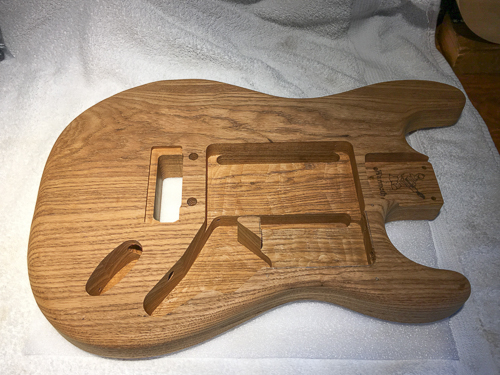Peter Knoot Custom Guitars
- Peter Knoot

- May 24
- 3 min read
Early builds
Starting in 2011, I focused on Stratocaster-style guitars using Warmoth bodies and necks. These were chosen for the very high wood quality and fit, as well as providing a lot of options for custom electronics installation.


Hexaphonic Guitars
I bought my first hexaphonic guitar, a Brian Moore i81.13 in Emerald Green with Graph Tech piezo pickups and a 13-pin output in 2005. It's a good guitar, but not perfect for me, so it started my interest in building hexaphonic guitars.
Meanwhile I did acquire a Fender GC-1, two Fishman Triple Play guitars (Fender and Godin), and a Line 6 Variax Standard, all variations on the theme (Analog GK, MIDI, and DSP in guitar).
A key moment was obtaining a Peavey AT-200 Auto-Tune guitar; that instrument was capable of amazing alternate tunings and guitar modeling, better than any of the previous technologies (most guitarists don't realize that it does so much more than tuning itself!), even though the actual guitar was not very good and the ATG did not have the full features. Well, that was easily solved - I built my own ATG guitar with proper construction, play ability, and most importantly a fully featured DSP implementation with the Antares ATG Luthier's Kit. I ended up buying their entire kit inventory when they discontinued ATG and now have the ability to provide customers with a custom-built ATG guitar.
Swamp Ash body in Oil finish, Roasted Birdseye Maple Neck
In 2017 I decided to give the Cycfi Research Nu Multi a try and built my first (of many since!) 19-pin guitar. For reasons described below, I wanted to retain a classic bridge pickup sound and combined the Nu Multi 6 with a set of Cycfi Research XR pickups. The combination is quite lovely, the ability to have both GK compatibility (I modified the early Nexus Breakout Box, now it's a standard feature) and clean single-string outputs is truly better than anything before it.
In addition to the modified Nexus box, I also designed a circuit now known as the Tone Block, to adjust the character of the (also very clean) XR pickups (look for the trimpot adjustment in the pickguard), as well as a method to install the Nu Multi next to an XR pickup in a Humbucker-sized bridge pickup cutout. Finally, I included a custom control that balanced the GK Synth Volume control voltage with the XR pickup outputs, like a continuous version of the GK MIX switch.
Walnut over Swamp Ash body, Maple Neck with Rosewood Fingerboard
To this day I build custom guitars like this one, albeit with the latest revisions of Nu Multi 6 and XR Spectra pickups. It's a very versatile instrument!
If one hexaphonic Nu Multi 6 pickup is great, why not have three? That was the next iteration, mostly to satisfy a curiosity about the pickup performance in different positions.
Triple Nu Multi 6 Experimental Guitar
This guitar featured a custom-designed touch-controlled pickup switching circuit as well as a custom-designed hexaphonic Voltage Controlled Filter (VCF) with Voltage Controlled Amplifier (VCA) board, similar to the SynQuaNon VCF and VCA Eurorack modules. Think of it as a Tone Block on steroids!
How about modifying a headless .strandberg* Boden guitar? I applied the same approach as the Nu/XR build to Boden Classic 6 in Malta Blue:
.strandberg* Boden Classic 6 in Malta Blue with Nu Multi 6 and 19-pin Output
This build is also currently available, either as a stand-alone guitar or as a package with Nexus or SynQuaNon 19-pin Breakout.
It's all in the pickups
After creating the SynQuaNon module line I realized that GK-2, GK-3, and now GK-5 hexaphonic pickups don't sound very good on their own. That makes them poor signal generators for single-string processing (because they are designed for pitch detection).
For a while piezo pickups (with RMC being the best IMHO) did a far better job at providing good-sounding string signals for our modules to process.
Enter the Cycfi Research Nu Multi pickups, which are very clean sounding magnetic pickups and are conveniently sized like single Fender pickups for easy installation. I've built many guitars with the Nu Multi 6 and have been very happy with the results. I'd pick them over piezo pickups overall.
While one can process the Nu Multi outputs through distortion or fuzz circuits, I was still left wanting a pickup that could produce a creamy tone all by itself. Hence the new Hex Distortion Pickup line! Now guitarists have more choices. See this Blog post for more details.


































































































































































Comments